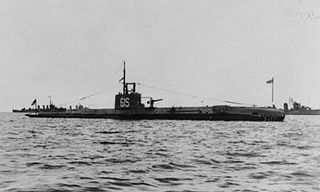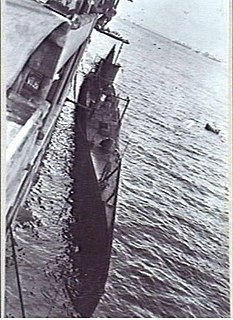
USS Sigourney (DD–81) was a Wickes-class destroyer in the United States Navy during World War I. She was the first ship named for James Butler Sigourney.

The first USS Twiggs (DD–127) was a Wickes-class destroyer in the United States Navy during World War I. She was named for Major Levi Twiggs. She was later transferred to the Royal Navy, as HMS Leamington and to the Soviet Navy as Zhguchi, before returning to Britain to star in the film The Gift Horse, which depicts the St. Nazaire Raid.
Vice Admiral Sir Gilbert Owen Stephenson, was a senior officer in the Royal Navy, a pioneer of anti-submarine techniques in the First World War, and most famous as an important naval training commandant during the Second World War.

BAPAlmirante Grau(CLM-81) is a De Zeven Provinciën-class cruiser that served in the Royal Netherlands and Peruvian navies. Completed for the Dutch in 1953 as HNLMS De Ruyter (C801), she was acquired by Peru in 1973 and served as fleet flagship. Almirante Grau underwent a major modernization program between 1985 and 1988 during which she was fitted with new weapons and electronics. She was the last gun cruiser in service in any navy before being decommissioned on 26 September 2017. In 2019, it was announced that she would be preserved as a museum ship.

HMS Swordfish (61S) was a first-batch S-class submarine built for the Royal Navy during the 1930s. Commissioned in 1932, she was given the pennant number 61S and was assigned to the 2nd Submarine Flotilla.

HNLMS Zwaardvisch (S814) was the lead ship of the Royal Netherlands Navy's Zwaardvisch-class submarine, which was based on the British T class. The submarine was originally ordered as HMS Talent (P322) and built by Vickers Armstrong, Barrow, and John Brown & Company, Clydebank. It served mainly in the Pacific against the Japanese during the war, operating under both British and US operational command in Ceylon and Australia. In 1950, the vessel was renamed HNLMS Zwaardvisch. She was sold and broken up for scrap in 1963.

HMS P47 was a Royal Navy U-class submarine built by Vickers-Armstrong. She was transferred to the Royal Netherlands Navy before completion and renamed HNLMS Dolfijn.

SS Batavier II was a steam packet for the Batavier Line that sailed between Rotterdam and London for most of her career. The ship was built in 1897 by the Gourlay Brothers of Dundee. The Dutch ship could carry a limited amount of freight and up to 321 passengers. She was rebuilt in 1909 which increased her length by over 5 metres (16 ft).

SS Batavier V was a steam packet for the Batavier Line that sailed between Rotterdam and London for most of her career. The ship was built in 1897 by the Gourlay Brothers of Dundee. The Dutch ship could carry a limited amount of freight and up to 428 passengers. She was rebuilt in 1909 which increased her length by over 5 metres (16 ft).

The Batavier Line was a packet service between Rotterdam and London from 1830 until the 1960s. The line was established by the Nederlandsche Stoomboot Maatschappij.

HMAS Doomba was a Royal Australian Navy (RAN) warship of World War II. Built for the Royal Navy around the end of World War I as the Hunt-class minesweeper HMS Wexford, the ship only saw two years of service before she was decommissioned in 1921 and sold to the Doomba Shipping Company. The vessel was renamed SS Doomba, converted into a passenger ship, and operated in the waters around Brisbane until 1939, when she was requisitioned by the RAN for wartime service. Serving first as an auxiliary minehunter, then an auxiliary anti-submarine vessel, HMAS Doomba was purchased outright by the RAN in 1940, and served until early 1946, when she was sold and converted into a linseed oil lighter. Doomba was scuttled off Dee Why, New South Wales in 1976.

O 24, laid down K XXIV was an O 21-class submarine of the Royal Netherlands Navy that saw service during World War II. The most famous occupant of O-24 was Piet de Jong, who was the commanding officer from 1944 until 1946 and who later became Minister of Defence in 1963 and served as Prime Minister of the Netherlands from 1967 until 1971.
O 15 was a O 12-class submarine of the Royal Netherlands Navy that saw service during World War II. It was the only submarine of the O 12 class built by Wilton-Fijenoord of Rotterdam. It was one of many Dutch ships doing convoy duty during the Spanish Civil War. When World War II broke out O 15 was stationed in Curaçao. It returned to Europe and was based in Dundee, whence it patrolled the coast of Norway and accompanied convoys to Archangelsk. The sub survived World War II and was taken out of active duty just after the Japanese surrender. It was demolished in 1946 in Hendrik-Ido-Ambacht.
HNLMS O 7 was a unique patrol submarine of the Royal Netherlands Navy for use in the home waters of Europe. The ship was built by the Maatschappij Fijenoord shipyard in Rotterdam. The submarines diving depth was 40 metres. O 6 was very similar to the O 7 and they are sometimes regarded as one class.

HMS Vesper was a V-class destroyer of the British Royal Navy that saw service in World War I and World War II.

HMS Venomous (ex-Venom), was a Modified W-class destroyer of the British Royal Navy that saw service in the Russian Civil War and World War II.

The second HMS Wivern, was a Modified W-class destroyer of the British Royal Navy that saw service in World War II.

O 23, laid down as K XXIII, was an O 21-class submarine of the Royal Netherlands Navy that saw service during World War II. During the war she sank and damaged several ships.

O 10 was a O 9-class patrol submarines of the Royal Netherlands Navy. The ship was built by Nederlandsche Dok en Scheepsbouw Maatschappij shipyard in Amsterdam.

K XV was one of five K XIV class submarines built for the Royal Netherlands Navy. She served during World War II.















